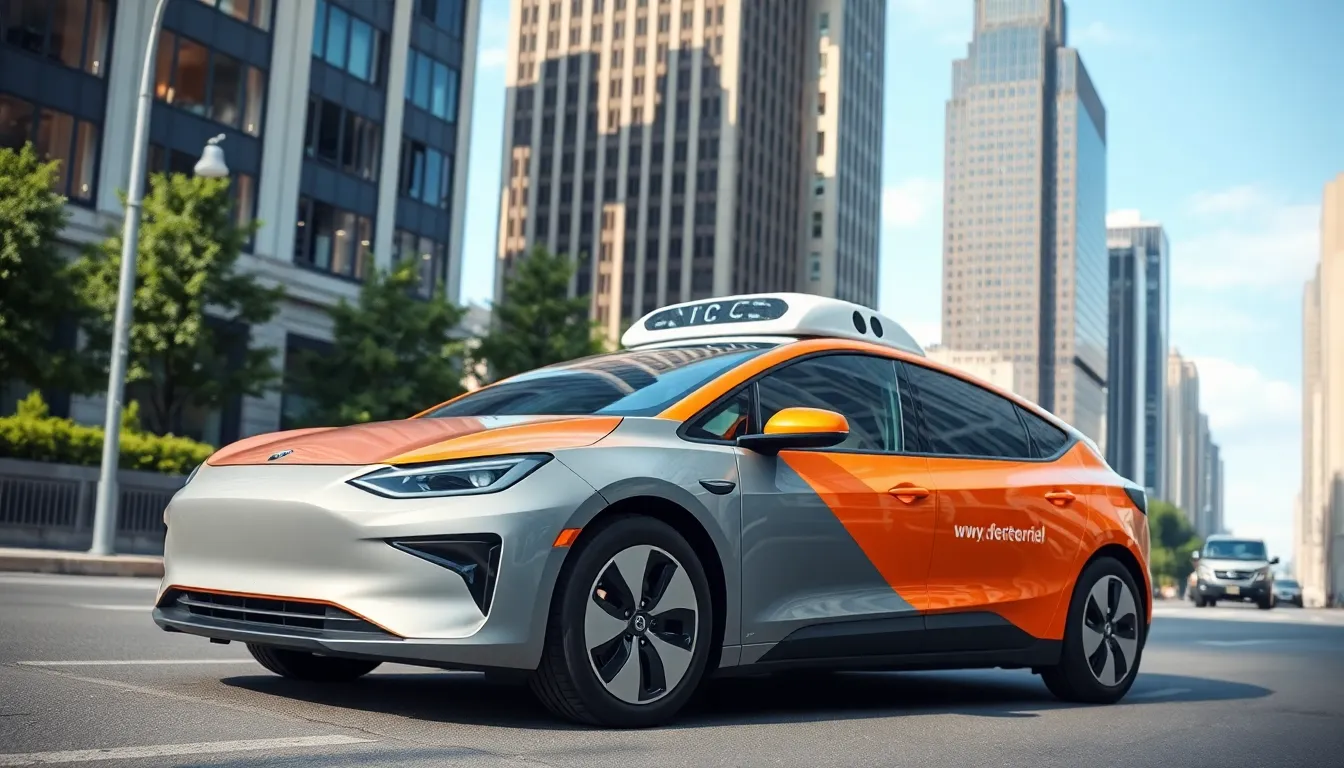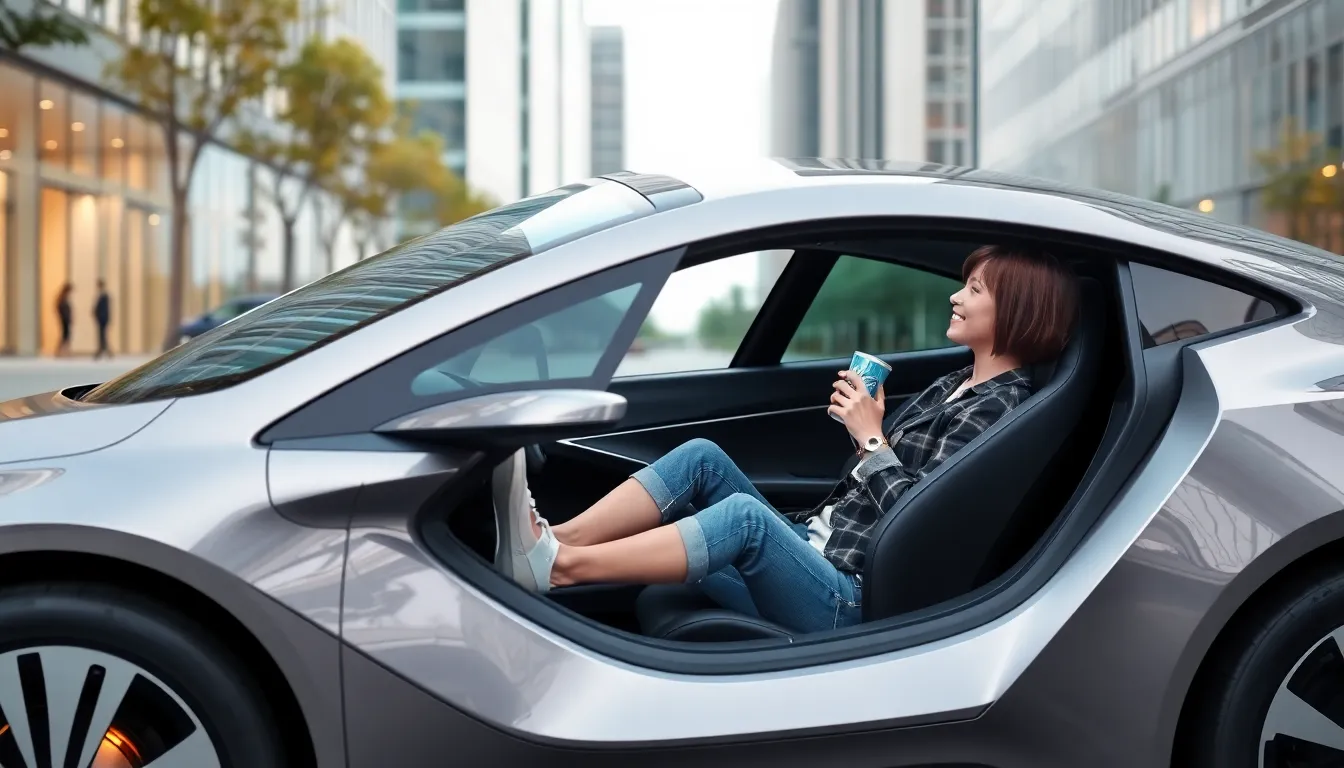Imagine a world where your car not only drives itself but also offers you a front-row seat to the latest Netflix series while you sip your favorite coffee. Self-driving electric cars are not just a futuristic dream; they’re zooming into reality faster than you can say “traffic jam.” With technology advancing at lightning speed, these vehicles promise to revolutionize the way we travel—no more road rage or searching for a parking spot.
Table of Contents
ToggleOverview of Self-Driving Electric Cars
Self-driving electric cars represent a significant shift in the automotive industry. These vehicles integrate advanced sensors, AI algorithms, and electric powertrains to navigate roads with minimal human intervention. Their design prioritizes safety, efficiency, and reduced emissions, contributing to a greener environment.
Technological advancements have made it easier for these cars to recognize obstacles, interpret traffic signals, and respond to changing conditions. Industry leaders, like Tesla and Waymo, have invested heavily in developing robust self-driving systems that rely on machine learning and real-time data.
Comfort and convenience for passengers are key features of self-driving electric cars. Users can engage in activities like streaming content or working while the car takes over driving responsibilities. Electric powertrains enhance the overall experience by offering quick acceleration and quiet operation.
Market studies predict that the demand for self-driving electric cars will grow significantly in the coming years. Statistics indicate that by 2030, autonomous vehicle sales could reach 33 million units annually. This projected growth reflects increasing consumer interest in innovative transportation solutions.
Regulatory challenges persist, however. Government bodies worldwide are working to develop policies that ensure the safe integration of these vehicles into existing traffic systems. Collaborative efforts between manufacturers and regulators will shape future guidelines and standards.
The future of travel hinges on self-driving electric cars. The combination of advanced technology and sustainable driving has the potential to revolutionize daily commuting and long-distance travel. As this technology matures, it promises to address common frustrations faced by current drivers.
Technology Behind Self-Driving Electric Cars

Self-driving electric cars rely on cutting-edge technology to transform transportation. Key components include sophisticated systems that enhance performance.
Autonomous Driving Systems
Autonomous driving systems utilize advanced sensors to collect data about the vehicle’s surroundings. Cameras, radar, and LiDAR work together to create a comprehensive view, aiding in navigation. Machine learning algorithms process this information to make real-time driving decisions. Industry leaders like Tesla and Waymo employ these technologies, ensuring vehicles adapt to various driving conditions. By combining high-definition maps with real-time data, these systems enhance safety and minimize the risk of accidents.
Electric Vehicle Technology
Electric vehicle technology forms the backbone of self-driving cars, enabling efficient energy consumption. Battery packs provide the necessary power, allowing for longer ranges. Regenerative braking systems recapture energy during braking, optimizing overall efficiency. Additionally, software plays a crucial role in managing energy levels and vehicle performance. Tesla and other manufacturers continually innovate in battery technology, contributing to faster charging times and improved range. The synergy between electric powertrains and autonomous systems fosters an eco-friendly and sustainable mode of transportation.
Benefits of Self-Driving Electric Cars
Self-driving electric cars offer substantial benefits that enhance travel efficiency and sustainability. Key advantages include safety enhancements and a positive environmental impact.
Safety Enhancements
Advanced sensors and AI algorithms significantly improve safety. These vehicles assess their surroundings using cameras, radar, and LiDAR, creating a detailed environmental map. Real-time data processing helps identify and react to potential hazards, reducing accident risks. Studies show that self-driving technology can decrease crashes caused by human error, accounting for over 90% of road incidents. Moreover, features like automatic emergency braking and adaptive cruise control ensure prompt responses to changing conditions. In addition, constant updates to driving algorithms reinforce safety by learning from previous incidents on the road. This innovative technology positions self-driving electric cars as a safer alternative to traditional vehicles.
Environmental Impact
Self-driving electric cars support a greener planet through reduced emissions. Electric powertrains produce zero tailpipe emissions, contributing to improved air quality in urban areas. Enhanced energy efficiency further lowers the carbon footprint associated with transportation. Regenerative braking systems play a crucial role, converting kinetic energy back into usable power, thus maximizing battery life. The shift towards electric vehicles aligns with global efforts to combat climate change, with an estimated reduction of carbon emissions by 1.5 billion tons annually by 2030 if electric adoption increases. Investing in self-driving electric cars not only transforms personal mobility but also fosters a more sustainable future.
Challenges Facing Self-Driving Electric Cars
Self-driving electric cars face significant challenges that impact their widespread adoption. Addressing these challenges is critical as technology advances.
Regulatory Issues
Regulatory hurdles pose substantial barriers to self-driving electric cars. Governments around the world are developing policies to manage their integration into existing traffic systems. Regulations often vary by region, creating uncertainty for manufacturers and consumers. Compliance with safety standards, liability laws, and data privacy requirements complicates the legal landscape. Additionally, defining the operational parameters for autonomous driving remains a pressing issue. As regulations evolve, flexibility will be essential to keep pace with technological advancements.
Public Perception
Public perception plays a vital role in the acceptance of self-driving electric cars. Concerns about safety and reliability frequently arise among potential users. Many individuals associate autonomous technology with risks, stemming from high-profile accidents involving self-driving vehicles. Trust must be built through education and transparent communication. Demonstrations of safety improvements and success stories can influence consumer attitudes. As awareness grows, acceptance of self-driving technology is likely to increase, paving the way for broader adoption.
Self-driving electric cars are set to redefine how people experience travel. With advancements in technology making these vehicles safer and more efficient, the future looks promising. As they integrate seamlessly into daily life, passengers can expect enhanced comfort and convenience, transforming mundane commutes into enjoyable experiences.
While challenges remain in regulation and public perception, the potential benefits are undeniable. A shift towards these vehicles could lead to safer roads and a significant reduction in environmental impact. As the industry continues to innovate, self-driving electric cars may soon become the norm, paving the way for a greener and more efficient transportation landscape.





